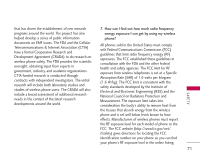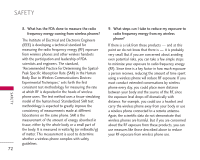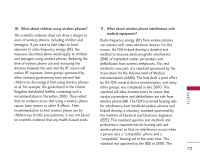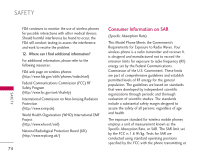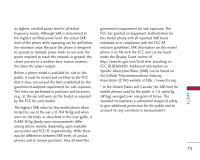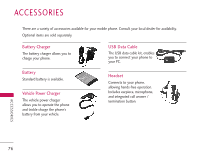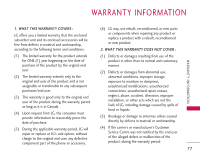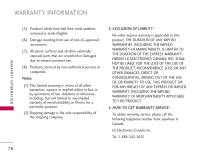LG AX490 User Guide - Page 75
the Institute of Electrical and Electronic Engineers
 |
View all LG AX490 manuals
Add to My Manuals
Save this manual to your list of manuals |
Page 75 highlights
10. What about children using wireless phones? 11. What about wireless phone interference with The scientific evidence does not show a danger to medical equipment? users of wireless phones, including children and Radio frequency energy (RF) from wireless phones teenagers. If you want to take steps to lower can interact with some electronic devices. For this exposure to radio frequency energy (RF), the reason, the FDA helped develop a detailed test measures described above would apply to children method to measure electromagnetic interference and teenagers using wireless phones. Reducing the (EMI) of implanted cardiac pacemakers and time of wireless phone use and increasing the defibrillators from wireless telephones. This test distance between the user and the RF source will method is now part of a standard sponsored by the reduce RF exposure. Some groups sponsored by Association for the Advancement of Medical other national governments have advised that instrumentation (AAMI). The final draft, a joint effort children be discouraged from using wireless phones by the FDA, medical device manufacturers, and many at all. For example, the government in the United other groups, was completed in late 2000. This Kingdom distributed leaflets containing such a standard will allow manufacturers to ensure that SAFETY recommendation in December 2000. They noted cardiac pacemakers and defibrillators are safe from that no evidence exists that using a wireless phone wireless phone EMI. The FDA has tested hearing aids causes brain tumors or other ill effects. Their for interference from handheld wireless phones and recommendation to limit wireless phone use by helped develop a voluntary standard sponsored by children was strictly precautionary; it was not based the Institute of Electrical and Electronic Engineers on scientific evidence that any health hazard exists. (IEEE). This standard specifies test methods and performance requirements for hearing aids and wireless phones so that no interference occurs when a person uses a "compatible" phone and a "compatible" hearing aid at the same time. This standard was approved by the IEEE in 2000. The 73






